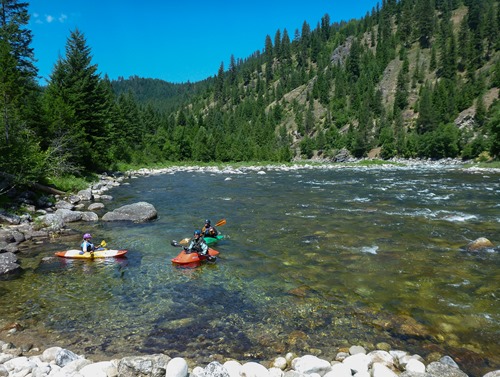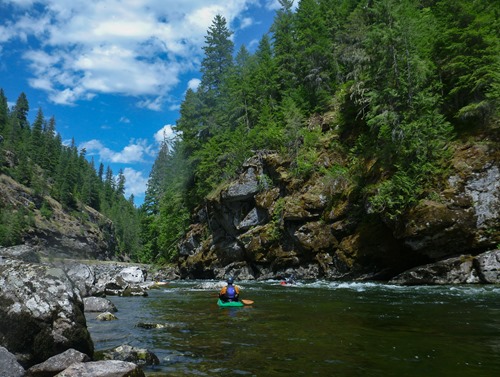 The following day, I bid adieu to the Holcombe’s and motored north through a pastoral landscape that was more reminiscent of Upstate New York than the Rocky Mountain West. In contrast to the massive ranches of Colorado, the green, rolling, Idahoan fields were parceled into manageable family homesteads and punctuated by the archetypical wooden barn. The large, bare-wood barns displayed a unique architecture unlike those of my New York childhood, and sadly showed their age as they slowly succumbed to gravity. As I witnessed firsthand in my youth in rural New York, failing barns are a clear indicator of an end of an era as family farms fade into the past. The farms stirred a part of my soul that had been dormant for decades, and as I continued north in my travels, I was filled simultaneously with both nostalgia and a bit of melancholy.
The following day, I bid adieu to the Holcombe’s and motored north through a pastoral landscape that was more reminiscent of Upstate New York than the Rocky Mountain West. In contrast to the massive ranches of Colorado, the green, rolling, Idahoan fields were parceled into manageable family homesteads and punctuated by the archetypical wooden barn. The large, bare-wood barns displayed a unique architecture unlike those of my New York childhood, and sadly showed their age as they slowly succumbed to gravity. As I witnessed firsthand in my youth in rural New York, failing barns are a clear indicator of an end of an era as family farms fade into the past. The farms stirred a part of my soul that had been dormant for decades, and as I continued north in my travels, I was filled simultaneously with both nostalgia and a bit of melancholy.
The rolling fields eventually gave way to a much grander landscape that traded green grasses for tall, arid mountains that were cut sharply by the mighty Salmon River. Not surprisingly, the area reminded me of the Snake River’s Hell’s Canyon that lay just a few dozen miles to the west. Continuing on, I reached the last vestiges of civilization in Kooskia, and steered my van eastward along the perfectly named Clearwater River. The air temperature was much more comfortable than the past several days, but still, as I drove into the forested wilderness, I could not help but wish that I was floating and splashing in the gin-clear river water. After I traveled twenty miles upstream, a roadless river entered that was quickly identified as the enviable Selway River. Having never laid eyes on the highly regarded river, I expected my thoughts to remain with it until I realized that the other half of the confluence was provided by the river that I had been seeking all day—the Lochsa River—and that my playful daydreams would soon be realized in the transparent waters. Before 5 o’clock, I reached camp at the Wilderness Gateway Campground that the Fornstrom’s had secured a day earlier and promptly cracked a cold one in honor of Alan Jackson’s classic song. The long evening provided much needed rest and a perfect opportunity to just hang out with Cindy and Stacey vacation-style.
Even before leaving Colorado, when I told people of my upcoming trip to Idaho, they all extolled the Lochsa River, saying what mighty fun it is. But as our trip neared and eventually became reality, it became apparent that the flows on the Lochsa would be far below the optimal levels. Like all of the rivers we paddled in Idaho, it was right around 2000 cfs, and the locals found that to be embarrassingly inadequate for whitewater kayaking. But once again, we were derived from the manky creeks of Colorado and were even eager for a low water run on the Lochsa.
There are two whitewater sections of the Lochsa that are typically paddled—the Upper and the Lower—and that are neatly divided by the Wilderness Gateway campground. At higher water, the Upper is usually the more formidable of the two, but as we learned on our trip, difficulty levels are extremely level-dependent.
On the 6th of July, we set forth on the Upper section of the Lochsa about a dozen miles upstream of camp. As I previously alluded, the most striking aspect of the run was the extreme clarity of the water. The rapids were almost exclusively Class 3 in difficulty and pool-drop in character, so whenever we approached a rapid, the deep, slow moving pools would give way to increasingly quick water and a shallower bottom. These shallow bottoms revealed the rounded rocks in exquisite detail through the clear water, and I vowed that I would bring snorkel gear on my next Idaho adventure. In absence of snorkeling equipment, I instead entered each rapid laying prone upside down on the backdeck of my kayak with my eyes wide open to observe firsthand the illusion of flying over the rocky bottom as if on a magic carpet. Even though the rapids of the Upper Lochsa were definitely fun, at the lower water level, we opted to take out a few miles upstream of camp and call it a day. We arrived back at camp to a quiet solitude that I can rarely recall. To be quite honest, I didn’t particularly like our campsite as it was covered heavily in a canopy of trees, but at that point in the trip and in that spot, I found a level of relaxation and peace that is the envy of every vacationer.
On our last day in Idaho, we set out on the Lower Lochsa with the knowledge that it would provide a little more challenge than the Upper at the low flows. And to start out with, Cindy and I had a little appetizer in the form of 100 yards of Boulder Creek through the campground to the put-in. Personally, I couldn’t resist hopping on even a short stretch of water that shares its name with my favorite hometown kayak run. But much like my local run and staying true to its name, there were more rocks than water which caused a bit of heartache (or handache) as we bounced slowly towards our awaiting friends on the Lochsa. With the little stunt thankfully behind us, we got started on the real run for the day.
In general and not surprisingly, the character of the river remained similar to that of the Upper with large cedars standing proudly on the fern lined banks and more crystal clear water. About half way through the run, we were finally greeted with a few technical rapids with some punch to them. Quite honestly, I can’t remember the difference between Otter Slide, Morning Glory, Bloody Mary, Grim Reaper, Shoestring, Horsetail Falls, and Lochsa Falls, but I do remember the enjoyment I felt as I navigated my little playboat around unforeseen holes while catching eddies like I was paddling the Numbers. Once in a while, the rapids got the best of me when I flipped over, but I barely got wet due to my newfound backdeck roll that I had been perfecting throughout the trip in the warm water. 11 miles and almost 4 hours after we started, we lifted our little plastic boats from the Idaho water for the last time of the trip and begrudgingly continued our journey east. Our three camper vans traveled another 30 miles up towards Lolo Pass to the point where the Lochsa officially begins at the confluence of Crooked Fork Creek and Colt Killed Creek. I suppose that it was only appropriate that our final, quiet evening in Idaho was spent at the source of one our favorite Idaho rivers.
Back to Road Trip 2013 Main Page
Read the previous Road Trip 2013 article, Kelly’s Whitewater Park
Continue reading Road Trip 2013 with the next article, Montana
Check out a sampling of photos in the gallery below:
Click here to open the photo album in its own window


[…] Continued from Road Trip 2013: Lochsa River […]